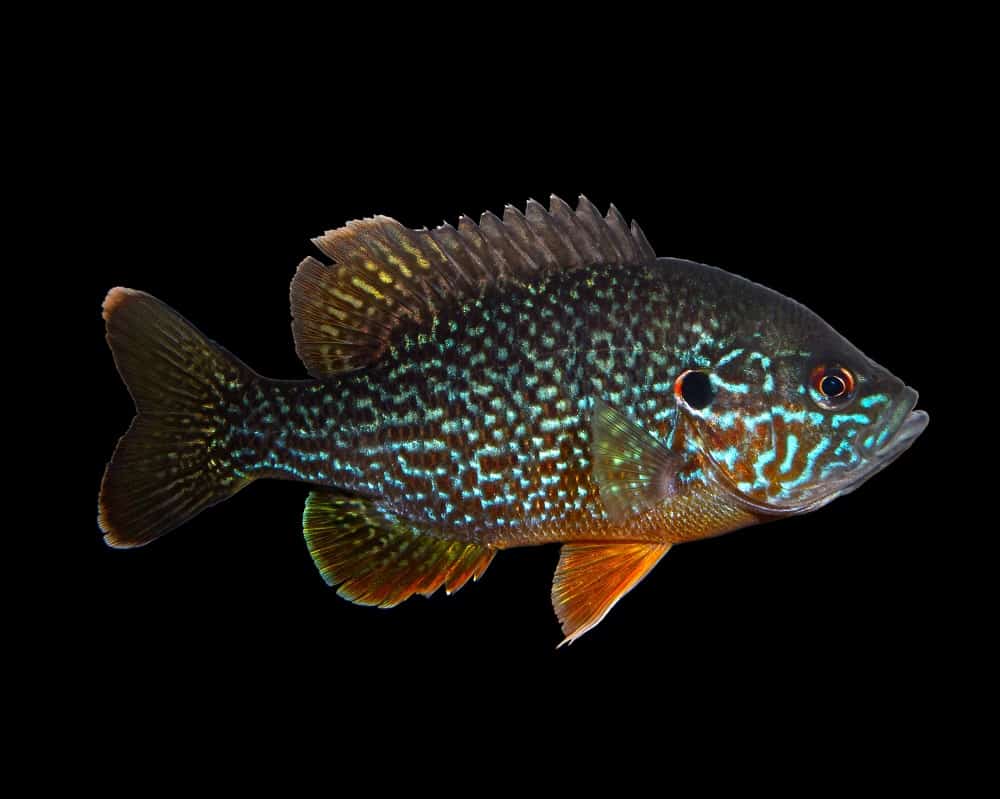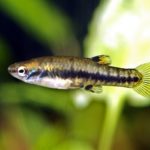The scientific name for this species is Lepomis cyanellus.
This species is native to the middle of the United States, particularly in the Gulf Coast and the Great Lakes to the North. The distribution of these fish has expanded accidentally and they are now commonly seen across the entire United States and parts of Mexico.
This accidental expansion is as a result of people introducing these fish into public lakes and private ponds. This allows them to travel with the water, breed and spread out to explore a wider habitat. In 1975 it was noticed that green sunfish are one of the first species to return to streams that have dried up as a result of the summer sun.

The green sunfish is very unlikely to be seen in southern Alabama. This is because there is a limit on the habitat and accessibility of resources. The green sunfish also face competition from red-spotted sunfish and bluegill fish.
They can live in a huge variety of habitats. They are most often found in large or small streams, swamps, ponds, and springs. They are occasionally found in reservoirs and large rivers, although this is much less common.
Care guide
Tank size
The smallest tank that you should keep these fish in has a volume of 55 or 75 gallons. The absolute minimum tank size is 30 gallons for a single fish, however, this is not advised.
If you wish to have a tank with multiple sunfish, allocate a minimum of 10 to 15 gallons of water per fish. You can set up an elaborate tank system to keep all 13 sunfish species in. For this, we recommend a 200-gallon tank measuring about 8 feet long.
Tank mates
Green sunfish are best kept alone in a tank. If you must keep them with other animals, your best options are to keep them as part of a school or with a fish that is much bigger.
For the school option, we recommend choosing other green sunfish, other sunfish species, or aggressive Cichlid species.
Same species tanks
These species can be kept in same species tanks, provided it is sufficiently large.
Water parameters
The temperature of the water in a green sunfish tank should be between 50 and 80 degrees Fahrenheit (10 to 26.6 degrees Celsius). The pH level of the water must be between 6.5 and 7.8.
They are commonly found in slow-moving waters with sandy, gravel, or bedrock bases. They can handle very poor water quality and are commonly seen in very muddy waters.
What to put in their tank
Green sunfish need a full tank with plenty of decorative items and foliage. The ideal tank for these fish is wooded and full of plants. They also like hiding near large piles of rocks.
The inclusion of these decorations provides natural breaks and barriers in the tank. This goes a long way to reducing the aggression levels that the green sunfish exhibit. This also allows them to exhibit their natural hiding behaviors.
As green sunfish are most commonly seen in flowing creeks, their ideal habitat will have a current of some form.
Common diseases
These are relatively hardy fish, although when the population density is high, they are susceptible to bacterial, fungal, and parasitic diseases.
The most common disease is columnaris, although rarely is this fatal. If you notice any of your fish developing this disease you will need to remove them immediately from the tank to prevent horizontal transmission.
Saprolegnia spp. is the most common fungal infection and is often linked to dramatic drops in temperature. To prevent this from developing, keep the water temperature of the tank consistent and allow the fish to acclimate to the tank temperature adequately.
Other common diseases include black grubs, white grubs, and yellow grubs. These are not going to shorten the lifespan of the green sunfish but they do make them less appealing for purchase.
These infections cannot be treated so you must take steps to prevent the infection from developing in the beginning. To do this, limit the access to birds and do not have too many snails in the tank.
Food and diet
In the wild, green sunfish will eat crayfish, small fish, and insects. This makes them naturally carnivorous, and in captivity, you will need to feed them crickets and bloodworms a couple of times per week. They will take a little time to adjust to a diet primarily consisting of pellets or food flakes.
Other food sources for these fish include snails and mollusks, turtle food, frogs, fish eggs, zooplankton, bryozoans, invertebrates, and plants. Frozen shrimp, earthworms, krill, blackworms, Mysis shrimp, mosquito larvae, and other similar animals are good food choices.
These fish will grow faster on a primarily pellet-based diet instead of living or frozen foods.
Lifespan
In the wild, these fish will live for between 4 and 6 years. In captivity, some of these species have been known to live to the age of 7.5. In exceptional cases, some green sunfish have lived to the age of 10.
Appearance
These fish are a greenish-blue in color on the main body. The scales are ridged with bones and flecked with specks of yellow. You will also see areas of yellow on their ventral sides (near their stomachs).
The sides of their heads and the covers of their gills are decorated with blue stripes which are broken lines. This means that they are commonly confused with bluegill fish.
Near the back of their dorsal fin (on the upper side of their body) you will find a dark spot. This is located very close to the anal fins. There is another dark spot on their ear plates.
The green sunfish has a relatively large mouth and an elongated snout that stops under the center of the eyes.
The pectoral (side) fins are short and have rounded edges. Each fin has between 13 and 14 pectoral fin rays. These fish have a dorsal fin containing 10 dorsal spines. Their tail is homocercal (it has 2 lobes that are equal in size and shape).
Size
When fully grown, green sunfish will measure between 4 and 8 inches in length. This is approximately equal to 102 to 203 mm. The largest green sunfish ever recorded measured 12 inches (30 cm) long and weighed 2.2 lbs (960 g). They more commonly weigh around or just below a pound.
Behavior and temperament
This species of fish is known to be aggressive. It is not well suited to communal living and will often attempt to become a ruler of the tank. They are very territorial and will fight to defend their space. They are known to chase after fish much larger than themselves while protecting their territory,
Any fish small enough to fit in the mouth of a green sunfish should and will be considered food.
Breeding
The spawning period for this species is between May and July. The act of breeding is facilitated through the production of sound. They are prolific breeders and tend to breed on the sandy base of streams or their tanks.
The males make nests by carving out dips in the sandy substrate, near rocks. Sometimes this will be sufficient to attract a mate, otherwise, the males will emit grunts to lure females in. These fish have a courtship dance that consists of the pair circling the nest until the female lays her eggs inside it.
The female lays between 2,000 and 26,000 eggs at once and then disappears, leaving the male to guard the children. They take between 3 and 5 days to hatch, during which time the male does not leave his protective duties.
During this time he will fan the eggs with his fins to keep them clean and oxygenated. The hatched fish stay close to the nest for the first few days of their lives and then will leave to live their own lives.
The optimal breeding temperature for green sunfish is between 68 and 72 degrees Fahrenheit (20 and 22 degrees Celsius). The breeding season will vary according to the water temperature.
Gender Differences: Male vs. Female
There is a mild sexual dimorphism shown in the green sunfish species. This is more obvious during the mating season as the appearance of the fish will change at this time. The males tend to be a little larger than their female counterparts and their bodies are more square.
The males will become much brighter and more colorful and you may see milt (fish semen) coming out of the vent. The females have a full and rounded abdomen during the breeding season.
Fun facts
- The green sunfish was first described in 1819 by a medical botanist called Constantine Samuel Refinesque.
- These fish are believed to have a polarization-sensitive vision that humans and most vertebrates are lacking in. This can help them to enhance the visibility of prey in scattering media.








